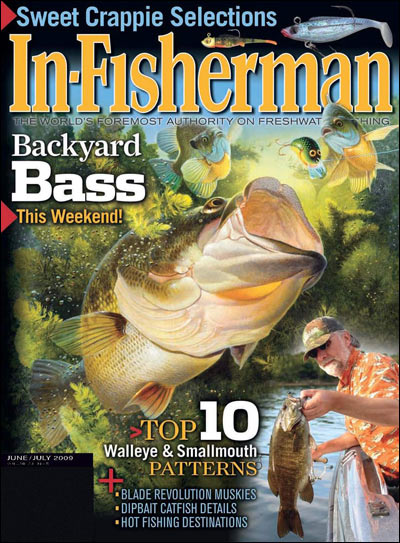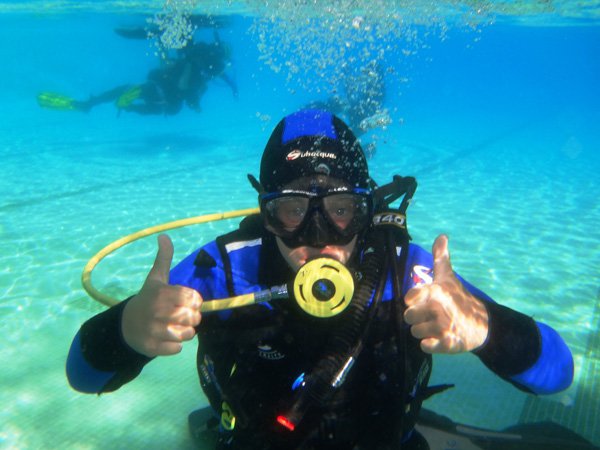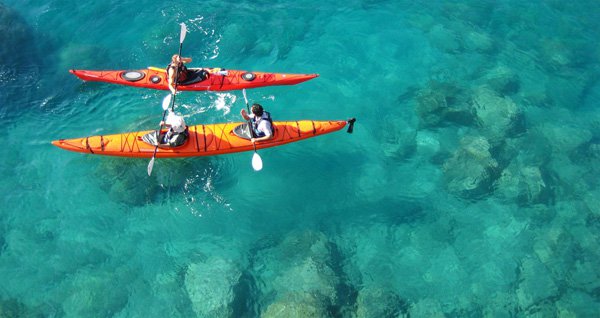1. Saugers See in the Dark
Walleyes are known for their marble-like eyes, which let them see well in dim light. Their retina has a layer of reflective pigment, called the tapetum lucidum, that intensifies any light the eye receives. (It's the same membrane that causes a cat's eyes to glow yellow.) But the walleye's close relative, the sauger, has even better night vision because the tapetum covers a much larger portion of its retinas.
2. Black, But Just Barely
Ever wonder where the term "black bass" came from? The fry of smallmouth bass turn coal black within a few days after they hatch. Even though the fry of largemouth and other bass species do not turn black, all members of the group (genus Micropterus) are referred to as black bass.
3. Orange Delight
Researchers studying walleye vision found that orange is the color most visible to walleyes, followed by yellow and yellow green. Surprisingly, red is the least visible color. No wonder you find so many orange and chartreuse lures in the tackle boxes of savvy walleye anglers.
4. On the Cool Side
White and striped bass are members of the temperate bass family, as opposed to black bass, which belong to the sunfish family. The term "temperate bass" refers to the moderate water temperature preference of members of this family. As a rule, they prefer temperatures a little lower than those preferred by largemouth or smallmouth bass.
5. Lights Out? Let's Eat
Research has shown that a sudden decrease in light level triggers walleyes to bite. That explains why the fish usually turn on just as the sun is disappearing below the horizon and the light intensity is rapidly decreasing. It also accounts for the hot bite that starts when the dark clouds preceding a thunderstorm roll in.
[pagebreak]
6. Not So Special
Trout are the only kind of fish with an adipose fin, right? Wrong. Several other fish species, including catfish, bullheads, madtoms, smelt, ciscoes and whitefish, also have an adipose fin (the small fin on the back just in front of the tail).
7. Tiny Teeth, But What a Bite
Flathead catfish have a tooth pad consisting of hundreds of tiny, recurved teeth on the roof of their mouth. The pad helps them hold their prey securely, so it can't wiggle around and escape. So if you're inclined to stick your hand into a flathead's mouth to dislodge your hook, forget it. You might pull your hand out minus the skin.
8. Mud Cats in Name Only
Flatheads are often called mud cats, giving anglers the impression that they scavenge dead food items off the bottom. But flatheads are more apt to eat live fish than any other catfish species. Channel cats are most likely to consume dead, stinky food (and bait) and blue cats are intermediate in their food preference.
9. Hungry Mothers
The very best time to catch a trophy walleye is five to seven weeks after the fish have completed spawning. That's when the big females, famished after not having eaten for nearly two months, go on the prowl for food. And with the natural supply of baitfish at its annual low, they're likely to hit almost anything you throw at them.
10. Sturgeons Big and Small
Members of the sturgeon family are the largest fish inhabiting the fresh waters of North America-and some are also among the smallest. The white sturgeon, which is found in rivers along the Pacific Coast, has been known to reach a weight of almost a ton, and today's anglers of the Pacific Northwest commonly catch whites in the 200- to 300-pound range. Shovelnoses, on the other hand, seldom exceed a few pounds in weight in their Midwestern home waters.
[pagebreak]
11. On the Edge
Ever wonder why the teeth of a pike or muskie easily shear your line, while those of an equally toothy walleye rarely do? In cross-section, the teeth of a walleye are round, but those of a pike oruskie have a razor-sharp edge. So don't forget to tie on a wire leader when you're chasing those esocids.
12. No Wonder It's So Skinny
What freshwater fish found in North America makes the longest spawning migration? The winner, hands down, is the American eel. The females spend most of their lives in big rivers like the Mississippi. When spawning time approaches, they swim downstream to join the males at the river mouth, then they swim to the Sargasso Sea (a portion of the North Atlantic) to spawn.
13. Bladder Control
You might have noticed that some fish pulled from deep water can be released and will swim right back down, but others have trouble descending. That's because some fish (physostomous species like trout) can "burp" air as they're being pulled up, relieving the gas build-up in their swim bladders, while others (physoclistous species like walleyes) do not have a connection between the swim bladder and the gut, so their swim bladders expand, greatly increasing their buoyancy.
14. Kings of Crunch
Redear sunfish are called shellcrackers in some parts of their range because of their habit of eating aquatic snails, which they crush with special grinding teeth in their throat. Where snails are scarce, redears will forage on various small crustaceans, insects and fish fry.
15. The Original Chamois Fly
One of the least known but most effective baits for trout is the water worm, which is the larval form of the crane fly (those big, slow-moving bugs that look like giant mosquitoes). You can often find water worms by digging through the mud and sticks of a beaver dam on your favorite trout stream.
[pagebreak]
16. Latch on to the Right Leech
Leeches are one of the top baits for walleyes, but make sure you're using the right leech species. Ribbon leeches, which have firm bodies and minimal suction, make excellent bait, but a walleye will turn up its nose at a horseleech or medicine leech, which have soft, squishy bodies and strong suction.
17. Waterdogs as Puppies
Water dogs, which are the larval form of a tiger salamander, make good bait for bass, walleyes and pike. But once the young salamanders lose their gills and turn into adults, they don't work nearly as well. To prevent water dogs intended for bait from developing into adults, keep them refrigerated in water at a temperature of no more than 50 degrees.
18. Yummy! A Worm Inside Out
Channel cats love catalpa worms, which can be found on the leaves of catalpa trees from late spring through summer. To make a catalpa worm even more irresistible, cut off the head and then poke a matchstick through the body to turn the worm inside out. The extra scent helps cats find the bait more quickly.
19. Madtom Mealtime
One of the very best baits for walleye and smallmouth bass is the tadpole madtom, also known as the willow cat. These tiny catfish look a lot like bullheads, but the dorsal, caudal (tail) and anal fins are all connected. Be extremely careful when hooking a willow cat for bait. Their needle-sharp pectoral fins can prick you much worse than a bee sting.
20. Catfish in a Can
You might have trouble finding a bait shop that carries willow cats, but you can catch your own by stringing together some empty pop cans and then sinking them in a lake or river backwater inhabited by the tiny fish. Leave the cans overnight and pick them up the next morning; like other catfish, willow cats like to swim into holes, so the pop cans make an inexpensive trap.
[pagebreak]
21. Never Trust the Ice
You've probably heard that it's safe to walk on 3 inches of ice or drive a car on 10 inches. But is the ice ever really safe? No! Schools of carp can gather under the ice and wear it away, occasionally even opening a hole. And groundwater might well up from the depths and melt the ice, as famously happened on several Minnesota lakes during the winter of 2002-2003.
22. Salmon With Handle
Not sure if that big salmon you caught is a coho or a chinook? Just grab it around the base of the tail and try to lift it. If it slips through your fingers, it's probably a coho; if it doesn't, it's a chinook. The bony structure of a chinook's tail is much more rigid, making it easier to "tail" the fish.
23. Take the Temperature
Pike and muskies are both classified as cool-water fish, but there is a definite difference in the water temperature they prefer, especially among the larger members of each species. Pike more than 30 inches long favor water temperatures from 50 to 55 degrees, while muskies prefer temperatures of 67 to 72 degrees. Another big difference: Pike feed actively throughout the year and are a popular target of ice fishermen. Muskies feed much more sporadically in winter and are rarely caught by ice anglers.
24. Picky Eaters
Although most anglers believe muskies are voracious feeders, consuming just about everything in sight, they're actually much less aggressive than pike. Muskies are considerably more selective, and will examine your offering more closely. They'll often follow your bait for a distance and then turn away at the last second. A pike, on the other hand, will attack practically any kind of lure or bait that passes its way.
25. Muskies Gone Bad
Most of the stories of the muskie's voracious feeding habits are myth, but there are some notable exceptions, including documented cases of muskies taking small swimming dogs and even attacking humans splashing around in the shallows! In one Minnesota lake, a cordoned-off swimming area had to be closed after a rogue muskie found its way inside the netting and bit a small boy.
[pagebreak]
26. Teeth Spare
Many anglers believe that pike lose their teeth in the summer and don't bite. In fact, both pike and muskies continually shed old teeth and grow new ones. While it's true that pike fishing often gets tough during the summer months, the poor bite is probably related to a glut of baitfish or the fact that pike often move into deeper, cooler water as the summer progresses.
27. Sexist Walleyes
Would you believe that the gender of a baitfish could make a big difference in your fishing success? A male fathead minnow, which has a black head covered with spawning tubercles in spring, is much less effective than a female fathead, which is more silvery and apparently exudes a more attractive odor to walleyes, pike and other game fish.
28. Vive le Difference
Everyone knows that smallmouth bass love rocks, but in Canadian Shield lakes or other waters where the bottom is almost all rock, they could be anywhere. In fact, in such waters where rocks and rocky bottom are ubiquitous, smallmouths will oftned on several Minnesota lakes during the winter of 2002-2003.
22. Salmon With Handle
Not sure if that big salmon you caught is a coho or a chinook? Just grab it around the base of the tail and try to lift it. If it slips through your fingers, it's probably a coho; if it doesn't, it's a chinook. The bony structure of a chinook's tail is much more rigid, making it easier to "tail" the fish.
23. Take the Temperature
Pike and muskies are both classified as cool-water fish, but there is a definite difference in the water temperature they prefer, especially among the larger members of each species. Pike more than 30 inches long favor water temperatures from 50 to 55 degrees, while muskies prefer temperatures of 67 to 72 degrees. Another big difference: Pike feed actively throughout the year and are a popular target of ice fishermen. Muskies feed much more sporadically in winter and are rarely caught by ice anglers.
24. Picky Eaters
Although most anglers believe muskies are voracious feeders, consuming just about everything in sight, they're actually much less aggressive than pike. Muskies are considerably more selective, and will examine your offering more closely. They'll often follow your bait for a distance and then turn away at the last second. A pike, on the other hand, will attack practically any kind of lure or bait that passes its way.
25. Muskies Gone Bad
Most of the stories of the muskie's voracious feeding habits are myth, but there are some notable exceptions, including documented cases of muskies taking small swimming dogs and even attacking humans splashing around in the shallows! In one Minnesota lake, a cordoned-off swimming area had to be closed after a rogue muskie found its way inside the netting and bit a small boy.
[pagebreak]
26. Teeth Spare
Many anglers believe that pike lose their teeth in the summer and don't bite. In fact, both pike and muskies continually shed old teeth and grow new ones. While it's true that pike fishing often gets tough during the summer months, the poor bite is probably related to a glut of baitfish or the fact that pike often move into deeper, cooler water as the summer progresses.
27. Sexist Walleyes
Would you believe that the gender of a baitfish could make a big difference in your fishing success? A male fathead minnow, which has a black head covered with spawning tubercles in spring, is much less effective than a female fathead, which is more silvery and apparently exudes a more attractive odor to walleyes, pike and other game fish.
28. Vive le Difference
Everyone knows that smallmouth bass love rocks, but in Canadian Shield lakes or other waters where the bottom is almost all rock, they could be anywhere. In fact, in such waters where rocks and rocky bottom are ubiquitous, smallmouths will oft
Small Stream Tactics: Sight Fishing

Divers Recover Silver Coins From 16th-century Swedish shipwreck

How to Be Safe In A Kayak and Canoe

Copyright © www.mycheapnfljerseys.com Outdoor sports All Rights Reserved